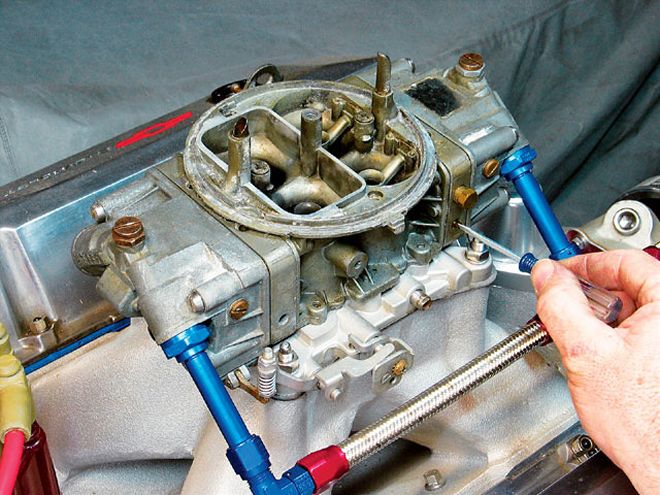

Our buddy Tim Moore loves to cruise for old carbs. Think of him as a swap-meet resurrection specialist. Know that old wheeze that one man's junk is another man's treasure? Moore loves to rehabilitate those abused, discarded Holley carburetors that others have relegated to the junk pile. He'll buy 'em for $25 or $30 and give 'em the once-over.
"I've got one 750 I bought for $25 that's the best carburetor I've ever owned," Moore told us. There is much to be said for the value of applied knowledge over drilling even deeper into your Visa card statement. Moore's approach follows a more fiscally responsible route. Choose the carb wisely and then treat it to a carefully choreographed resurrection. This story can be used as reference for virtually any 4160- or 4150-version Holley four-barrel carb. There are few tricks. The whole notion here is to restore the carb back to its factory roots and then apply sound tuning only after you're assured the fuel mixer performs properly.
Moore's Holley rehab always starts with a Holley TricKit. Yes, this kit is more expensive than the discount versions, but he prefers the TricKit for its plethora of essential parts that are otherwise difficult to find. The TricKit includes tons of extra parts that any true car crafter will immediately store in his carb-tuner box for future hero adventures.
Once Moore has the distressed carb disassembled, the first thing he does is look for a warped personality. Abused Holleys follow a predictable course resulting from ham-fisted tuners who must be using a 11/42-inch torque wrench on the bowl screws. This warps the metering blocks and, in this case, the flat portion of the main carb body. Amazingly, while the body was warped, the metering blocks were salvageable. The good news is that even new metering blocks are affordable at just over $40 each.
Moore also completely disassembles the baseplate, removing the original throttle shafts to replace (if necessary) the small, white plastic bushings. According to Holley, all double-pumper carbs did not use the Teflon bushings, using instead Teflon-coated shafts, even though the shafts are usually machined to include them. If the throttle plates or shafts are damaged, Moore gets inexpensive replacements from Holley. Vacuum-secondary carbs only use seals on the secondary side. He blasts the baseplate, cleans it thoroughly, and then carefully reassembles it to ensure a factory-like idle and off-idle performance.
Then the rest of the carb is rejuvenated with stock power valves, jetting, and squirter sizes. Once back to stock, the carb can be tuned for the engine's individual requirements.
AdjustmentsMany carburetor tuners overlook the basic adjustments necessary for the carb to perform properly. Float level is an excellent place to start. Place the level just below the sight plug-period. Be sure the accelerator-pump system is adjusted properly. You should see fuel exit the squirter the moment each throttle shaft begins to move. No amount of squirter sizing will cure an off-idle bog if the linkage is way out of adjustment.
Finally, regardless of how you drive, your street engine spends much more time idling and at part-throttle than it ever does at wide-open throttle (WOT). So make sure the idle-mixture screws are adjusted properly to create a stable idle. An off-idle stumble can often be cured with a slightly richer idle-mixture adjustment, eliminating the need for major invasive idle circuit surgery.
Pay attention to the details and to reliable carb-adjustment techniques and you too could soon be on your way with a budget-based carb that runs like new-all from a frugal investment in time and effort.
Carb SpecsThe following chart lists the stock jetting, squirters, accelerator-pump cams, and power-valve components to return a modified PN 0-4779 back to its original configuration. With a carburetor of questionable or unknown history, it's always best to return the carb to its original configuration before beginning the fine-tuning operation.
For the purposes of this story, we will address the parts necessary to return a PN 0-4779-2 to its original specs. All of this information can be found in any recent Holley catalog under the pages marked Carburetion Numerical Listing.
Carburetor: 750-cfm Mechanical Secondary, PN 0-4779-2Primary main jets: 70Primary power valve: 6.5Primary accelerator-pump squirter: 0.028Secondary main jets: 80Secondary power valve: BlockedSecondary accelerator-pump squirter: 0.031
Parts List Component PN Price TricKit 37-933 ${{{80}}} Renew kit 37-485 34 Throttle-plate kit, 1111/416, no hole 26-94 8 Throttle-plate kit, 1111/416, 0.093 holes 26-95 8 Throttle-plate kit, 1111/416, 0.150 holes 26-96 11 Throttle-plate assembly, 1111/416 12R11147AP N/A Metering block, primary, 4779-2 134-155 41 Metering block, primary, 4779-6 34R11179AQ 43 Metering block, secondary 34R11041AQ 41 Secondary adjusting lever 26-137 30 Replacement fuel bowl, classic 134-103C N/A Replacement fuel bowl, standard 134-103 50 Fuel bowl, quick-change kit, primary 34-25 36 Fuel bowl, quick-change kit, secondary 34-26 35 Fuel bowl, primary 134-103 50 Fuel bowl, secondary 134-104 40 Accelerator-pump arm, metal 20-114 13 TH700-R4 TV-cable arm 20-121 N/A TH700-R4 TV-cable bracket 20-95 19